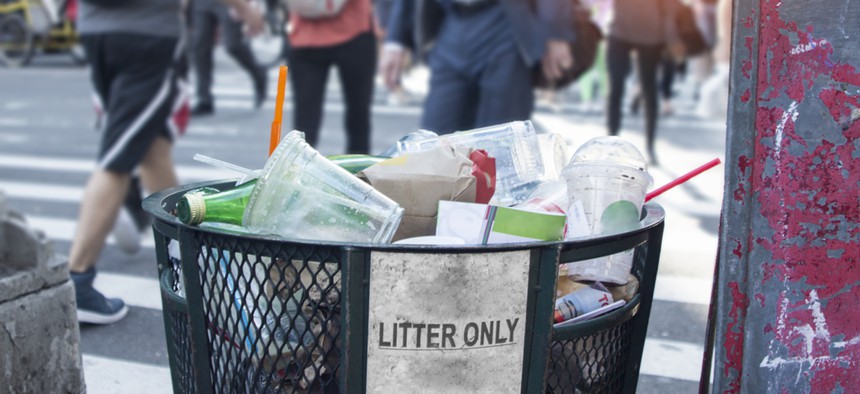New York City Unveils a Next-Generation Trash Can

Not New York City's new trash can. Shutterstock/Travis Wolfe
The winner of the BetterBin design competition is easier for sanitation workers to lift and deters bulk trash-dumpers. It could replace the ubiquitous green litter basket.
New Yorkers may not think much about the 23,000 steel litter baskets scattered around the city. “It’s a piece of street furniture that we take for granted,” says Robin Nagle, the in-house anthropologist at the New York City Department of Sanitation and an urban studies professor at New York University.
In use since the 1930s, the bins are ubiquitous but problematic: They weigh 30 pounds when empty, which means that garbage collectors have to lift as much as 100 pounds when they empty them. (In fact, garbage collectors hold one of the most dangerous jobs in the country, with a fatal injury rate of 33 deaths per every 100,000 workers, according to the U.S. Bureau of Labor Statistics.) The wide opening of the mesh bin allows trash to blow away and invites residents and business owners to dump bulky waste inside. The city’s notorious rats easily climb in and out of the baskets. And their aesthetics are not to everyone’s liking. As one reader put it to New York Magazine in 1972, “it’s really pretty ugly.”
Earlier this month, the city announced a new design for public waste bins following its year-and-a-half-long “BetterBin” competition, which drew over 200 submissions. The winning entry, by a design studio called Group Project, is sleeker, with a heavy-duty plastic bin partly nestled inside a metal stand.

The outer material can weather the daily grind of the streets of New York, according to Group Project team leader Colin Kelly, while the inner bin is removable and weighs only 10 pounds, making it easy for sanitation workers to empty it into their trucks. A cross bar at the top of the basket functions as both a hinge for the lid and a barrier to stop people from dumping bulk and household trash—which often overflowed the bins.
The city will put the new bins to the test early next year to see how they hold up to New York winters. After more tweaks, the department hopes to send out the final product for mass production, although Kathryn Garcia, the city’s sanitation commissioner, says there is no timeline for that yet.
Two finalists made it to the second stage of the competition—the runner-up featured handles for sanitation workers to grab. The decision ultimately came down to how the bins functioned when they were piloted in Flushing in Queens this past summer.
“At the end of the day, the [winning] design really met a lot of requirements, everything from durability to [being] lightweight, but still strong enough to not get blown over in strong winds,” says Garcia, adding that it met the cost limit of roughly $200. She also notes that the plastic was good at resisting damage when workers banged it against the truck while emptying the contents.
For such a seemingly simple piece of street furniture, the design process wasn’t easy, says Kelly. “A trash can for the home is one thing, but designing a trash can for millions of people to see every day and for the amount of the abuse, and wear and tear, was a challenge for sure.” (New York is a city of 8.6 million people.) There’s a lot to think about aside from understanding how garbage collectors handle the bins. For example, after the initial pilot test, Kelly’s team had to tweak their design to improve drainage on rainy days.
Contest entrants also attempted to solve another problem: litter. It’s not uncommon to find overflowing baskets and trash strewn along New York’s sidewalks, sometimes blocking the way of pedestrians. At least one report has named the Big Apple the dirtiest city in America.
In fact, the sanitation department has been trying to solve this problem for decades. The first reported trash-bin design contest held by the city dates back to 1930, says Nagle. The winning entry—a metal bin attached to a post on the street—is not what is in use today, but the winner, an art student from Chicago,was awarded $500. The city also came up with a few amusing anti-littering campaigns during the latter half of the 20th century. These included a talking trash bin called Lively Louie (the voice was provided by a live person hiding behind the receptacle) and a cartoon character named Phil D. Basket. None effectively changed public behavior, though. “There has not been enough research done on the socio-cultural understanding of how we [litter],” says Nagle.
Nagle is skeptical that the litter basket’s redesign will change people’s behavior, but she says these competitions aren’t futile. At the very least, they help raise public awareness, especially at a time when civic pride and protecting the environment are increasingly among people’s top issues. “Any kind of effort like this is always one piece of a larger strategy,” she says, adding that the city needs to better enforce anti-littering rules while amping up public education about waste.
Linda Poon is a staff writer at CityLab covering science and urban technology, including smart cities and climate change.
NEXT STORY: Considering RPA? Make sure you understand the security implications





